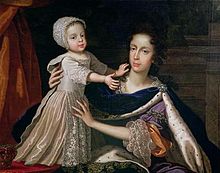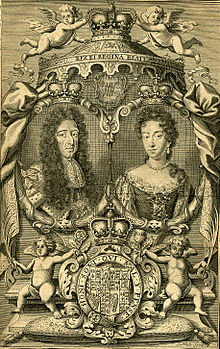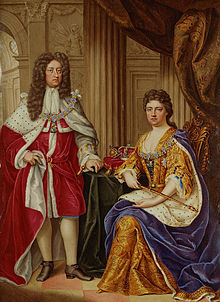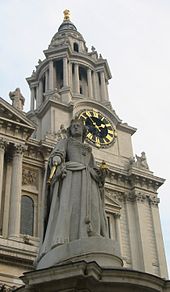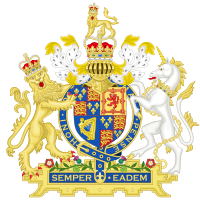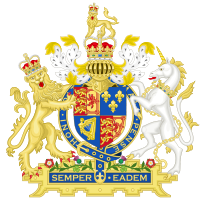- Anne, Queen of Great Britain
-
"Queen Anne" redirects here. For other uses, see Queen Anne (disambiguation).
Anne 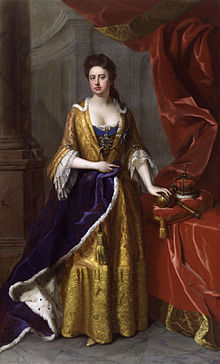
Portrait by Michael Dahl, 1705 Queen of England, Scotland and Ireland (more...) Reign 8 March 1702 – 1 May 1707 Coronation 23 April 1702 Predecessor William III & II Queen of Great Britain and Ireland (more...) Reign 1 May 1707 – 1 August 1714 Successor George I Spouse Prince George of Denmark Issue Prince William, Duke of Gloucester House House of Stuart Father James II & VII Mother Anne Hyde Born 6 February 1665
St James's Palace, LondonDied 1 August 1714 (aged 49)
Kensington Palace, LondonBurial 24 August 1714
Westminster Abbey, LondonSignature 
Anne (6 February 1665 – 1 August 1714[1]) ascended the thrones of England, Scotland and Ireland on 8 March 1702. On 1 May 1707, under the Act of Union, two of her realms, England and Scotland, were united as a single sovereign state, the Kingdom of Great Britain.
Anne's Catholic father, James II and VII, was deposed during the "Glorious Revolution" of 1688. Her Protestant sister Mary and Mary's husband, Anne's brother-in-law and cousin William III, became joint monarchs. After Mary's death in 1694, William continued as sole monarch until his own death and Anne's accession in 1702.
Anne favoured moderate Tory politicians, who were more likely than their opponents, the Whigs, to share her Anglican religious views. The Whigs grew more powerful during the course of the War of the Spanish Succession, until in 1710 Anne dismissed many of them from office. Her close friendship with Sarah Churchill, Duchess of Marlborough, turned sour as the result of political differences.
Despite seventeen pregnancies, Anne died without surviving children and was the last monarch of the House of Stuart. She was succeeded by her second cousin George I of the House of Hanover, who was a descendant of the Stuarts through his maternal grandmother, Elizabeth, daughter of James VI and I.
Contents
Early life
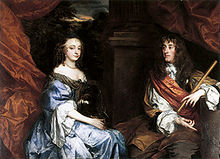 Anne's parents: the Duke and Duchess of York
Anne's parents: the Duke and Duchess of York
Anne was born at 11:39 p.m. on 6 February 1665 at St James's Palace, London, the fourth child and second daughter of James, Duke of York (afterwards James II and VII), and his first wife, Anne Hyde.[2] Her father's brother was King Charles II, who ruled the three kingdoms of England, Scotland and Ireland, and her mother was the daughter of Lord Chancellor Edward Hyde, 1st Earl of Clarendon. She was baptised into the Anglican faith at the Chapel Royal at St James's. Her older sister, Mary, was one of her godparents, along with Archbishop of Canterbury Gilbert Sheldon and Anne Scott, Duchess of Monmouth.[3] The Duke and Duchess of York had eight children, but Anne and Mary were the only ones to survive into adulthood.[4]
As a child, Anne suffered from an eye condition, which manifested as excessive watering known as "defluxion". For medical treatment, she was sent to France, where she lived with her paternal grandmother, Queen Dowager Henrietta Maria, at the Château de Colombes near Paris.[5] Following her grandmother's death in 1669, Anne lived with an aunt, Henriette Anne, Duchess of Orléans. On the sudden death of her aunt in 1670, Anne returned to England. Her mother died the following year.[6] As was traditional in the royal family, Anne and her sister were brought up separated from their father in their own establishment at Richmond, London.[7] On the instructions of Charles II, they were raised as Protestants.[8] They were placed in the care of Colonel Edward and Lady Frances Villiers,[9] and their education was focused on the teachings of the Anglican church.[10]
Around 1671, Anne first made the acquaintance of Sarah Jennings, who later became her close friend and one of her most influential advisors.[11] Jennings married John Churchill (the future Duke of Marlborough) in about 1678. He was the brother of the Duke of York's mistress, Arabella Churchill, and was to be Anne's most important general.[12]
In 1673, the Duke of York's conversion to Roman Catholicism became public. He married a Catholic princess, Mary of Modena, who was only six and half years older than Anne. Charles II had no surviving legitimate children, and so the Duke of York was next in the line of succession, followed by his two surviving daughters from his first marriage, Mary and Anne. Over the next ten years, the new Duchess of York had ten children, but all were either stillborn or died in infancy, leaving Mary and Anne second and third in the line of succession after their father.[13]
Marriage
In November 1677, Anne's elder sister married a Dutch prince, William of Orange, but Anne could not attend the wedding as she was confined to her room with smallpox.[14] By the time she recovered, Mary had already left for her new life in the Netherlands. Lady Frances Villiers contracted the disease, and died. Anne's aunt Lady Clarendon (the wife of Henry Hyde, 2nd Earl of Clarendon) was appointed as her new governess.[15] A year later, Anne and her stepmother visited Mary in Holland.[16]
Anne's father and stepmother retired to Brussels in March 1679 in the wake of anti-Catholic hysteria fed by the Popish Plot, and Anne visited them from the end of August.[16] In October, they returned to Britain, the Duke and Duchess to Scotland and Anne to England.[17] She visited her father and stepmother in Scotland from July 1681 until May 1682.[18] It was her last journey outside England.[19]
Anne's second cousin George of Hanover (her eventual successor) visited London for three months from December 1680, sparking rumours of a potential marriage between them.[20] Historian Edward Gregg dismissed the rumours as ungrounded as her father was essentially exiled from court, and the Hanoverians planned to marry Prince George to his first cousin Sophia Dorothea of Celle as part of a scheme to unite the Hanoverian inheritance.[21] Other rumours claimed she was courted by Lord Mulgrave (later made Duke of Buckingham), although he denied it. Nevertheless, as a result of the gossip, he was temporarily dismissed from court and despatched to Tangiers.[22]
On 28 July 1683 in the Chapel Royal, Anne married the Protestant Prince George of Denmark, brother of King Christian V of Denmark (and her second cousin once removed through Frederick II).[23] Though it was an arranged marriage, they were faithful and devoted partners.[24] They were given a set of buildings in the Palace of Whitehall known as the Cockpit as their London residence,[25] and Sarah Churchill became one of Anne's ladies of the bedchamber.[26] To mark their friendship, and at Anne's request, Anne and Sarah called each other the pet names Mrs. Morley and Mrs. Freeman respectively rather than use their formal styles and titles.[27] Within months of the marriage, Anne was pregnant, but the baby was stillborn in May. Anne recovered at the spa town of Tunbridge Wells,[28] and over the next two years, she gave birth to two daughters in quick succession, Mary and Anne Sophia.[29]
Accession of James II and VII
When Charles II died in 1685, Anne's father became king as James II in England and Ireland and James VII in Scotland. James was not well received by the English people, who were concerned about his Roman Catholicism.[30] Anne shared the general concern, and continued to attend Anglican services. As her sister Mary lived in the Netherlands, Anne and her family were the only members of the royal family attending Protestant religious services in England.[31] When her father tried to get Anne to baptise her youngest daughter into the Catholic faith, Anne burst into tears.[32] "The Church of Rome is wicked and dangerous", she wrote to her sister, "their ceremonies – most of them – plain downright idolatry."[33]
In early 1687, within a matter of days, Anne miscarried, her husband caught smallpox, and their two young daughters died of the same infection. Rachel Wriothesley, Lady Russell, wrote that George and Anne had "taken [the deaths] very heavily ... Sometimes they wept, sometimes they mourned in words; then sat silent, hand in hand; he sick in bed, and she the carefullest nurse to him that can be imagined."[34] Later that year, she suffered another stillbirth.[29]
Public alarm at James's Catholicism increased when his wife, Mary of Modena, became pregnant for the first time since James's accession.[35] In letters to her sister Mary, Anne raised suspicions that the Queen was faking her pregnancy in an attempt to introduce a false heir. She wrote, "they will stick at nothing, be it never so wicked, if it will promote their interest ... there may be foul play intended."[36] Anne suffered another miscarriage in April 1688, and left London to recuperate in the spa town of Bath.[37]
The Queen gave birth to a son (James Francis Edward) on 10 June 1688, and a Catholic succession became more likely.[38] Anne was still at Bath, so she did not witness the birth, which fed the belief that the child was spurious. Anne may have left the capital deliberately to avoid being present, or because she was genuinely ill,[39] but it is also possible that James desired the exclusion of all Protestants, including his daughter, from affairs of state.[40][41] "I shall never now be satisfied", Anne wrote to her sister Mary, "whether the child be true or false. It may be it is our brother, but God only knows ... one cannot help having a thousand fears and melancholy thoughts, but whatever changes may happen you shall ever find me firm to my religion and faithfully yours."[42]
To dispel rumours of a supposititious child, James had 40 witnesses attend a Privy Council meeting, but Anne claimed she could not attend because she was pregnant herself and then declined to read the depositions because it was "not necessary".[43]
"Glorious Revolution"
In what became known as the "Glorious Revolution", Anne's brother-in-law, William of Orange, invaded England on 5 November 1688 in an action that ultimately deposed King James. Forbidden by James to pay Mary a projected visit in the spring of 1687,[44] Anne corresponded with her and was aware of William's plans to invade.[45] On the advice of the Churchills,[41] she refused to side with James after William landed and instead wrote to William on 18 November declaring her approval of his action.[46] Churchill abandoned the unpopular king on the 24th. Prince George followed suit that night,[47] and in the evening of the following day James issued orders to place Sarah Churchill under house arrest at St James's Palace.[48] Anne and Sarah fled from Whitehall by a back staircase, and put themselves under the care of the bishop of London, spending one night in his house, and subsequently arrived at Nottingham on 1 December.[49] Two weeks later, Anne travelled to Oxford, where she met Prince George in triumph, escorted by a large company.[50] "God help me!", lamented James on discovering the desertion of his daughter on 26 November, "Even my children have forsaken me."[51] On 19 December, Anne returned to London, where she was at once visited by her brother-in-law William, and James fled to France on the 22nd.[52] Anne showed no concern at the news of her father's flight, and instead merely asked for her usual game of cards. She justified herself by saying that "she was used to play and never loved to do anything that looked like an affected constraint."[53]
In 1689, a Convention Parliament assembled in England and declared that James had effectively abdicated when he fled, and that the thrones of England and Ireland were therefore vacant. The Parliament or Estates of Scotland took similar action, and William and Mary were declared monarchs of all three realms.[54] The Bill of Rights 1689 and Claim of Right Act 1689 settled the succession. Anne and her descendants were to be in the line of succession after William and Mary, and they were to be followed by any descendants of William by a future marriage.[55] On 24 July 1689, Anne gave birth to a son, Prince William, Duke of Gloucester, who, though ill, survived infancy. As King William and Queen Mary had no children, it looked as though Anne's son would eventually inherit the crown.[56]
William and Mary
Soon after their accession, William and Mary rewarded John Churchill by granting him the Earldom of Marlborough and Prince George was made Duke of Cumberland. Anne requested the use of Richmond Palace and a parliamentary allowance. William and Mary refused the first, and unsuccessfully opposed the latter, both of which caused tension between the two sisters.[57] Anne's resentment grew worse when William refused to allow Prince George to serve in the military in an active capacity.[58] In January 1692, suspecting that Marlborough was secretly conspiring with James's followers, the Jacobites, William and Mary dismissed him from all his offices. In a public show of support for the Marlboroughs, Anne took Sarah to a social event at the palace, and refused her sister's request to dismiss Sarah from her household.[59] Lady Marlborough was subsequently removed from the royal household by the Lord Chamberlain, and Anne angrily left her royal lodgings and took up residence at Syon House, the home of the Duke of Somerset.[60] Anne was stripped of her guard of honour; courtiers were forbidden to visit her, and civic authorities were instructed to ignore her.[61] In April, Anne gave birth to a son who died within minutes. Mary visited her, but instead of offering comfort took the opportunity to berate Anne once again for her friendship with Sarah. The sisters never saw each other again.[62]
When Mary died of smallpox in 1694, William continued to reign alone. Anne became his heir apparent, since any children he might have by another wife were assigned to a lower place in the line of succession, and the two reconciled publicly. He restored her previous honours, and allowed her to reside in St James's Palace,[63] but excluded her from government and refrained from appointing her regent during his absences abroad.[64] Three months later, William restored Marlborough to his offices.[65]
According to James, Anne had written to him in 1696 requesting his permission to succeed William, and thereafter promising to restore the Crown to James's line at a convenient opportunity; he declined to give his consent.[66] If she did write, she was probably trying to ensure her own succession by attempting to prevent a direct claim by James.[67]
Act of Settlement
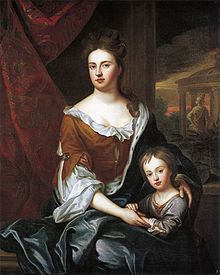 Anne with her son William, Duke of Gloucester, in a painting from the school of Sir Godfrey Kneller, circa 1694
Anne with her son William, Duke of Gloucester, in a painting from the school of Sir Godfrey Kneller, circa 1694
Anne's final pregnancy ended on 25 January 1700, when she miscarried a stillborn son. She had been pregnant at least seventeen times over as many years, and had miscarried or given birth to stillborn children at least twelve times. Of her five liveborn children, four died before reaching the age of two.[68] Anne suffered from bouts of "gout", pains in her limbs and eventually stomach and head, from at least 1698.[69] Based on her foetal losses and physical symptoms, one pathologist has diagnosed disseminated lupus erythematosus.[70] Alternatively, pelvic inflammatory disease could explain why the onset of her symptoms roughly coincided with her penultimate pregnancy.[70][71] Other suggested causes of her failed pregnancies are listeriosis,[72] rhesus incompatibility, diabetes, and intrauterine growth retardation.[73] Rhesus incompatibility, however, generally worsens with successive pregnancies, and so does not fit with the pattern of Anne's pregnancies, as her only son to survive infancy, William, Duke of Gloucester, was born after a series of stillbirths.[74] Experts also rule out syphilis, porphyria and pelvic deformation as incompatible with her medical history.[70][75]
Anne's gout rendered her lame for much of her later life.[76] Around the court, she was carried in a sedan chair, or used a wheelchair.[77] Around her estates, she used a one-horse chaise, which she drove herself "furiously like Jehu and a mighty hunter like Nimrod".[78] Her sedentary lifestyle resulted in her gaining weight; in Sarah's words, "she grew exceeding gross and corpulent. There was something of majesty in her look, but mixed with a gloominess of soul".[79] Sir John Clerk, 1st Baronet, described her in 1706 "under a fit of the gout and in extreme pain and agony, and on this occasion everything about her was much in the same disorder as about the meanest of her subjects. Her face, which was red and spotted, was rendered something frightful by her negligent dress, and the foot affected was tied up with a poultice and some nasty bandages. I was much affected by this sight …"[80]
Anne's sole surviving child, the Duke of Gloucester, died at the age of eleven on 30 July 1700. Anne ordered her household to observe a day of mourning every year on the anniversary of his death.[81] With William childless and Gloucester dead, Anne was the only individual remaining in the line of succession established by the Bill of Rights 1689. To address the succession crisis and preclude a Catholic restoration, the Parliament of England enacted the Act of Settlement 1701, which provided that, failing the issue of Anne and of William III by any future marriage, the Crown of England and Ireland would go to Sophia, Electress of Hanover, and her Protestant descendants. Sophia was the granddaughter of James VI and I through his daughter Elizabeth, who was the sister of Anne's grandfather Charles I. Dozens of genealogically senior Catholic claimants were disregarded. Anne's father died in September 1701. His widow, Anne's stepmother, the former Queen, wrote to Anne to inform her that her father forgave her and to remind her of her promise to seek the restoration of his line. Anne, however, had already acquiesced to the new line of succession created by the Act of Settlement.[82]
Reign
 Portrait by Charles Jervas
Portrait by Charles Jervas
Anne became Queen upon the death of William III on 8 March 1702, and was immediately popular.[83] In a speech to the English Parliament she distanced herself from her late Dutch brother-in-law and said, "As I know my heart to be entirely English, I can very sincerely assure you there is not anything you can expect or desire from me which I shall not be ready to do for the happiness and prosperity of England."[84]
Soon after her accession, Anne appointed her husband Lord High Admiral, giving him nominal control of the Royal Navy.[85] Anne gave control of the army to Lord Marlborough, whom she appointed Captain-General.[86] Marlborough also received numerous honours from the Queen; he was created a Knight of the Garter and was elevated to the rank of duke. The Duchess of Marlborough was appointed Groom of the Stole, Mistress of the Robes, and Keeper of the Privy Purse.[87]
Anne was crowned Queen on St George's Day, 23 April 1702.[88] Afflicted with gout, she was carried to Westminster Abbey in an open sedan chair, with a low back to permit her train to flow out behind her.[89] On 4 May, England was embroiled in the War of the Spanish Succession, in which England, Austria and Holland fought against France and Spain.[90] Charles II of Spain had died childless in 1700, and the succession was disputed by two claimants: the Habsburg Archduke Charles of Austria and the Bourbon Philip, Duke of Anjou.[91]
Act of Union
The Act of Settlement 1701, passed by the English Parliament, applied in England and Ireland but not Scotland, where a strong minority wished to preserve the Stuart dynasty and its right of inheritance to the throne.[92] In 1703, the Estates of Scotland responded to the Settlement by passing the Act of Security, which gave the Estates the power, if the Queen had no further children, to choose the next Scottish monarch from among the descendants of the royal line of Scotland.[93] The individual chosen by the Estates could not be the same person who came to the English throne, unless England granted full freedom of trade to Scottish merchants.[94] At first, Anne withheld royal assent to the act, but granted it the following year when the Estates threatened to withdraw Scottish support for England's wars.[95]
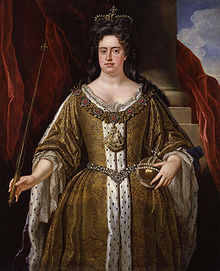 Portrait from the school of John Closterman, circa 1702
Portrait from the school of John Closterman, circa 1702
In its turn, the English Parliament responded with the Alien Act 1705, which threatened to impose economic sanctions and declare Scottish subjects aliens in England, unless Scotland either repealed the Act of Security or moved to unite with England.[96] The Estates chose the latter option, and commissioners were appointed by Queen Anne to negotiate the terms of a union.[97] Articles of Union were approved by the commissioners on 22 July 1706, and ratified by the Scottish and English Parliaments on 16 January and 6 March 1707 respectively.[98] Under the Acts of Union, England and Scotland became one realm, a united kingdom called Great Britain, on 1 May 1707.[99]
Two-party politics
Anne's reign was marked by the further development of a two-party system. In general, the Tories were supportive of the Anglican church and favoured the "landed interest" of the country gentry, while the Whigs were aligned with commercial interests and Protestant Dissenters. As a committed Anglican, Anne was inclined to favour the Tories.[100] Her first ministry was predominantly Tory, and contained such High Tories as Daniel Finch, 2nd Earl of Nottingham, and her uncle Laurence Hyde, 1st Earl of Rochester.[101] It was headed by Lord Godolphin and Anne's favourite the Duke of Marlborough, who were considered moderate Tories, along with the Speaker of the House of Commons, Robert Harley.[102]
Anne supported the Occasional Conformity Bill of 1702, which was promoted by the Tories and opposed by the Whigs. The bill aimed to disqualify Protestant Dissenters from public office by closing a loophole in the Test Acts, legislation that restricted public office to Anglican conformists. The existing law permitted nonconformists to take office if they took Anglican communion once a year. Anne's husband was placed in an unfortunate position when Anne forced him to vote for the bill, even though, being a Lutheran, he was an occasional conformist himself. The Whigs successfully blocked the bill for the duration of the parliamentary session.[103] Anne reinstituted the traditional religious practice of touching for the king's evil that had been eschewed by William as papist superstition.[104] After the Great Storm of 1703, Anne declared a general fast to implore God "to pardon the crying sins of this nation which had drawn down this sad judgement".[105] The Occasional Conformity Bill was revived in the wake of the storm,[106] but Anne withheld support, fearing its reintroduction was a ruse to cause a political quarrel. Once again it failed.[107]
The Whigs vigorously supported the War of the Spanish Succession and became even more influential after the Duke of Marlborough won a great victory at the Battle of Blenheim in 1704. Many of the High Tories, who opposed British involvement in the land war against France, were removed from office.[108] Godolphin, Marlborough, and Harley, who had replaced Nottingham as Secretary of State for the Northern Department, formed a ruling "triumvirate".[109] They were forced to rely more and more on support from the Whigs, and particularly from the Whig Junto—Lords Somers, Halifax, Orford, Wharton and Sunderland—whom Anne disliked.[110] Sarah consistently counselled the Queen to appoint more Whigs and reduce the power of the Tories, whom she considered little better than Jacobites, and the Queen became increasingly discontented with Sarah.[111]
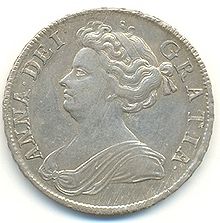 Half-crown coin of Queen Anne, 1708. The inscription reads in Latin: ANNA DEI GRATIA (Anne by the Grace of God).
Half-crown coin of Queen Anne, 1708. The inscription reads in Latin: ANNA DEI GRATIA (Anne by the Grace of God).
In 1706, Godolphin and Marlborough forced Anne to accept Lord Sunderland, a Junto Whig and Marlborough's son-in-law, as Harley's colleague as Secretary of State for the Southern Department.[112] Although this strengthened the ministry's position in Parliament, it weakened the ministry's position with the Queen, as Anne became increasingly irritated with Godolphin and with her former favourite, the Duchess of Marlborough, who supported Sunderland.[113] The Queen turned for private advice to Harley, who was uncomfortable with Marlborough and Godolphin's turn towards the Whigs. She also turned to Abigail Hill, a woman of the bedchamber who became more amenable to Anne as her relationship with Sarah deteriorated.[114] Abigail was related to both Harley and the Duchess, but was politically closer to Harley.[115]
The division within the ministry came to a head on 8 February 1708, when Godolphin and Marlborough insisted that the Queen had to either dismiss Harley or do without their services. When the Queen seemed to hesitate, Marlborough and Godolphin refused to attend a cabinet meeting. Harley attempted to lead business without his former colleagues, and several of those present including the Duke of Somerset refused to participate until they returned.[116] Her hand forced, the Queen dismissed Harley.[117]
The following month, Anne's Catholic half-brother James Francis Edward Stuart attempted to land in Scotland, with French assistance, in an attempt to establish himself as king.[118] Anne withheld royal assent from the Scottish Militia Bill 1708 in case the militia raised in Scotland was disloyal and sided with the Jacobites.[119] She was the last British sovereign to veto a parliamentary bill, although her action was barely commented upon at the time.[120] The invasion fleet never landed and was chased away by British ships commanded by Sir George Byng.[121]
In July 1708, the Duchess of Marlborough came to court with a bawdy poem, written by a Whig propagandist, that implied a lesbian relationship between Anne and Abigail. The Duchess wrote to Anne telling her she had damaged her reputation by conceiving "a great passion for such a woman ... strange and unaccountable".[122] At a thanksgiving service for a victory at the Battle of Oudenarde, Anne did not wear the jewels that Sarah had selected for her. At the door of St Paul's Cathedral, they had an argument that culminated in Sarah offending the Queen by telling her to be quiet.[123] Anne was dismayed. When Sarah forwarded an unrelated letter from her husband to Anne, with a covering note continuing the argument, Anne wrote back pointedly, "After the commands you gave me on the thanksgiving day of not answering you, I should not have troubled you with these lines, but to return the Duke of Marlborough's letter safe into your hands, and for the same reason do not say anything to that, nor to yours which enclosed it."[124]
Death of her husband
Anne was devastated by her husband's death in October 1708,[125] and the event proved a turning point in her relationship with the Duchess of Marlborough. The Duchess arrived at Kensington Palace shortly before George died, and after his death insisted that Anne leave Kensington for St James's Palace against her wishes.[126] Anne resented the Duchess's intrusive actions, which included removing a portrait of George from the Queen's bedchamber and then refusing to return it in the belief that it was natural "to avoid seeing of papers or anything that belonged to one that one loved when they were just dead".[127]
The Whigs used George's death to their own advantage. The leadership of the Admiralty was unpopular among the Whig leaders, who had blamed Prince George and his deputy George Churchill (who was Marlborough's brother) for mismanagement of the navy.[128] With Whigs now dominant in Parliament, and Anne distraught at the loss of her husband, they forced her to accept the Junto leaders Lord Somers and Lord Wharton into the cabinet. Anne, however, insisted on carrying out the duties of Lord High Admiral herself, without appointing a member of the government to take George's place as nominal head of the navy. Undeterred, the Junto demanded the appointment of the Earl of Orford, another member of the Junto and one of Prince George's leading critics, as First Lord of the Admiralty. Anne appointed the moderate Thomas Herbert, 8th Earl of Pembroke, on 29 November 1708. Pressure mounted on Pembroke, Godolphin and the Queen from the dissatisfied Junto Whigs, and Pembroke resigned after less than a year in office. Another month of arguments followed before the Queen finally consented to put the Earl of Orford in control of the Admiralty in November 1709.[129]
Sarah continued to berate Anne for her friendship with Abigail, and in October 1709, Anne wrote to the Duke of Marlborough asking that his wife "leave off teasing & tormenting me & behave herself with the decency she ought both to her friend and Queen".[130] On Maundy Thursday 6 April 1710, Anne and Sarah saw each other for the last time. According to Sarah, the Queen was taciturn and formal, repeating the same phrases—"Whatever you have to say you may put in writing" and "You said you desired no answer, and I shall give you none"—over and over.[131]
War of the Spanish Succession
As the expensive War of the Spanish Succession grew unpopular, so did the Whig administration.[132] The impeachment of Henry Sacheverell, a High Church Tory Anglican who had preached anti-Whig sermons, led to further public discontent. Anne thought Sacheverell ought to be punished for questioning the "Glorious Revolution", but that his punishment should only be a mild one to prevent further public commotion.[133] In line with her views, Sacheverell was convicted, but his sentence—suspension of preaching for three years—was so light as to render the trial a mockery.[134] In London, riots broke out in support of Sacheverell, but the only troops available to quell the disturbances were Anne's guards, and Secretary of State Sunderland was reluctant to use them and leave the Queen less protected. Anne declared God would be her guard and ordered Sunderland to redeploy her troops.[134]
 Tinted engraving of Anne from an atlas commissioned by Augustus of Saxony, 1706–1710
Tinted engraving of Anne from an atlas commissioned by Augustus of Saxony, 1706–1710
The Queen, increasingly disdainful of the Marlboroughs and her ministry, finally took the opportunity to dismiss Sunderland in June 1710.[135] Godolphin followed in August. The Junto Whigs were removed from office, although Marlborough, for the moment, remained as commander of the army. In their place, she appointed a new ministry, headed by Harley, which began to seek peace with France. Unlike the Whigs, Harley and his ministry were ready to compromise by giving Spain to the Bourbon claimant, Philip of Anjou, in return for commercial concessions.[136] In the parliamentary elections which soon followed his appointment, Harley, aided by government patronage, secured a large Tory majority.[137] In January 1711, Anne forced Sarah to resign her court offices, and Abigail took over as Keeper of the Privy Purse.[138] Harley was stabbed by a disgruntled French refugee, the Marquis de Guiscard, in March, and Anne wept at the thought he would die. He recovered slowly.[139] Godolphin's death by natural causes in September 1712 reduced Anne to tears; she blamed their estrangement on the Marlboroughs.[140]
The war was resolved by outside events. The elder brother of Archduke Charles, Emperor Joseph I, died in 1711 and Charles succeeded him in Austria, Hungary and Holy Roman Empire. To give him also the Spanish throne was no longer in Britain's interests, but the proposed Peace of Utrecht submitted to Parliament for ratification did not go as far as the Whigs wanted to curb Bourbon ambitions.[141] In the House of Commons, the Tory majority was unassailable, but the same was not true in the House of Lords. The Whigs secured the support of the Earl of Nottingham against the treaty by promising to support his Occasional Conformity bill.[142] Seeing a need for decisive action to erase the anti-Peace majority in the House of Lords, and seeing no alternative, Anne reluctantly created twelve new peers. Abigail's husband, Samuel Masham, was made a baron.[143] Such a mass creation of peers was unprecedented.[144] On the same day, Marlborough was dismissed as commander of the army.[144] The peace treaty was ratified and Britain's military involvement in the War of the Spanish Succession ended.[145]
By signing the Treaty of Utrecht, King Louis XIV of France recognised the Hanoverian succession in Britain.[146] Nevertheless, gossip that Anne and her ministers favoured the succession of her half-brother rather than the Hanoverians continued, despite Anne's denials in public and in private.[147] The rumours were fed by her consistent refusals to permit any of the Hanoverians to visit or move to England,[148] and by the intrigues of Harley and the Tory Secretary of State Lord Bolingbroke, who were in separate and secret discussions with her half-brother about a possible Stuart restoration until early 1714.[149]
Death
Anne was unable to walk between January and July 1713.[150] At Christmas, she was feverish, and lay unconscious for hours,[151] which led to rumours of her impending death.[152] She recovered, but was seriously ill again in March.[153] On 27 July 1714, during Parliament's summer recess, she dismissed Harley as Lord Treasurer.[154] She was rendered unable to speak by a stroke on 30 July 1714, the anniversary of Gloucester's death, and on the advice of the Privy Council handed the treasurer's staff of office to Whig grandee Charles Talbot, 1st Duke of Shrewsbury.[155] She died of suppressed gout, ending in erysipelas, at around 7:30 a.m. on 1 August 1714.[156] She was buried in an almost-square coffin[157] beside her husband and children in the Henry VII chapel on the South Aisle of Westminster Abbey on 24 August.[158]
The Electress Sophia had died on 8 June, two months before Anne, so the Electress's son, George I, Elector of Hanover, inherited the British Crown pursuant to the Act of Settlement 1701. The possible Catholic claimants, including Anne's half-brother, were ignored. The Elector's accession was relatively stable: a Jacobite rising in 1715 failed.[159] Marlborough was re-instated,[160] and the Tory ministers were replaced by Whigs.[161]
Legacy
The Duchess of Marlborough "unduly disparaged" Anne in her memoirs,[41] and her prejudiced recollections persuaded many biographers that Anne was "a weak, irresolute woman beset by bedchamber quarrels and deciding high policy on the basis of personalities".[162] The Duchess wrote of Anne:
She certainly meant well and was not a fool, but nobody can maintain that she was wise, nor entertaining in conversation. She was ignorant in everything but what the parsons had taught her when a child … Being very ignorant, very fearful, with very little judgement, it is easy to be seen she might mean well, being surrounded with so many artful people, who at last compassed their designs to her dishonour.[163]In the opinion of historian Maureen Waller, traditional assessments of Anne as fat, constantly pregnant, under the influence of favourites, and lacking political astuteness or interest may derive from male chauvinist prejudices against women.[164] Author David Green noted, "Hers was not, as used to be supposed, petticoat government. She had considerable power; yet time and time again she had to capitulate."[165] Professor Edward Gregg concluded that Anne was often able to impose her will, even though, as a woman in an age of male dominance and preoccupied by her health, her reign was marked by an increase in the influence of ministers and a decrease in the influence of the Crown.[166] She attended more Cabinet meetings than any of her predecessors or successors,[167] and presided over an age of artistic, literary, economic and political advancement that was made possible by the stability and prosperity of her reign.[168] In architecture, Sir John Vanbrugh constructed Blenheim Palace and Castle Howard.[169] Writers such as Daniel Defoe, Alexander Pope and Jonathan Swift flourished.[170] Henry Wise laid out new gardens at Blenheim, Kensington, Windsor and St James's.[171] The union of England and Scotland, which Anne had fervently supported,[172] created Europe's largest free trade area.[173] Waller concludes that the political and diplomatic achievements of Anne's governments, and the absence of constitutional conflict between monarch and parliament during her reign, indicate that she chose ministers and exercised her prerogatives wisely.[174]
Titles, styles, honours and arms
Royal styles of
Queen Anne of Great Britain
Reference style Her Majesty Spoken style Your Majesty Alternative style Madam[175] Titles and styles
- 6 February 1665 – 28 July 1683: Her Highness The Lady Anne[176]
- 28 July 1683 – 8 March 1702: Her Royal Highness The Princess Anne of Denmark[177]
- 8 March 1702 – 1 August 1714: Her Majesty The Queen
The official style of Anne before 1707 was "Anne, by the Grace of God, Queen of England, Scotland, France and Ireland, Defender of the Faith, etc." The claim to France was only nominal, and had been asserted by every English king since Edward III.[178] After the Union, her style was "Anne, by the Grace of God, Queen of Great Britain, France and Ireland, Defender of the Faith, etc."
Arms
As queen regnant, Anne's coat of arms before the Union were the Stuart royal arms, in use since 1603: Quarterly; I and IV grandquarterly, Azure three fleurs-de-lis Or (for France) and Gules three lions passant guardant in pale Or (for England); II, Or, a lion rampant within a double tressure flory-counter-flory Gules (for Scotland); III, Azure, a harp Or stringed Argent (for Ireland). In 1702, Anne adopted the motto Semper eadem (Always the same), the same motto used by Queen Elizabeth I.[179]
The Act of Union declared that: "the Ensigns Armorial of the said United Kingdom be such as Her Majesty shall think fit".[180] In 1707, the Union was heraldically expressed by the impalement, or placing side-by-side in the same quarter, of the arms of England and Scotland, which had previously been in different quarters. The new arms were: Quarterly; I and IV, Gules three lions passant guardant in pale Or (for England) impaling Or a lion rampant within a double tressure flory-counter-flory Gules (for Scotland); II, Azure, three fleurs-de-lis Or (for France); III, Azure, a harp Or stringed Argent (for Ireland).[179] In Scotland, a separate form of arms was used on seals until the Act of Union.[181]
Coat of arms of Anne as Queen of England from 1702 to 1707Coat of arms of Anne as Queen of Great Britain from 1707 to 1714Issue
Name Birth Death Burial Notes Stillborn daughter 12 May 1684[182] Westminster Abbey[29] Mary or Marie 2 June 1685
Palace of Whitehall8 February 1687
Windsor CastleWestminster Abbey[29] Anne Sophia 12 May 1686
Windsor Castle2 February 1687
Windsor Castle[29] or Whitehall[183]Westminster Abbey[29] Miscarriage 21 January 1687[184] Stillborn son 22 October 1687
Whitehall[185]Westminster Abbey[29] Anne gave birth at seven months, but the baby "lay dead a full month within her".[185] Miscarriage 16 April 1688[186] William, Duke of Gloucester 24 July 1689
Hampton Court Palace30 July 1700
Windsor Castle[187]Westminster Abbey[29] Mary 14 October 1690
St James's PalaceWestminster Abbey[29] She was two months premature,[188] and "lived about two hours".[189] George 17 April 1692
Syon HouseWestminster Abbey[29] He "lived a few minutes",[190] just long enough to be baptised.[191] Stillborn daughter 23 March 1693
Berkeley House[192]Westminster Abbey[29] Stillbirth 21 January 1694 Contemporary chronicler Narcissus Luttrell did not specify a gender, saying only that Anne "miscarried of a dead child".[193] Modern historians Edward Gregg and Alison Weir do not agree on whether it was a son[194] or possibly a daughter.[195] Miscarried daughter[196] 17[197] or 18[198] February 1696 Miscarriage 20 September 1696[198] Luttrell said Anne "miscarried of a son".[199] Dr Nathaniel Johnson told Theophilus Hastings, 7th Earl of Huntingdon, in a letter dated 24 October 1696, "Her Royal Highness miscarried of two children, the one of seven months' growth, the other of two or three months, as her physicians and midwife judged: one was born the day after the other."[200] If so, the smaller foetus was probably a blighted twin.[70] Miscarriage 25 March 1697[201] Miscarriage early December 1697[202] According to G. de L'Hermitage, the Dutch resident in London, Anne miscarried twins who were "too early to determine their sex".[203] Other sources say the pregnancy ended in a stillborn son.[195] Stillborn son 15 September 1698[204] St George's Chapel, Windsor Castle[195] James Vernon wrote to Charles Talbot, 1st Duke of Shrewsbury, that Anne's physician thought the foetus "might have been dead 8 or 10 days".[203] Stillborn son 24 January 1700
St James's[205]Westminster Abbey[195] Contemporary sources say Anne gave birth at seven and a half months, after the foetus had been dead for a month.[206] Ancestry
Ancestors of Anne, Queen of Great Britain 16. Henry Stuart, Lord Darnley 8. James I of England 17. Mary, Queen of Scots 4. Charles I of England 18. Frederick II of Denmark 9. Princess Anne of Denmark 19. Sofie of Mecklenburg-Schwerin 2. James II of England 20. Antoine of Bourbon, Duke of Vendôme 10. Henry IV of France 21. Jeanne III of Navarre 5. Princess Henrietta Maria of France 22. Francesco I de' Medici, Grand Duke of Tuscany 11. Marie de' Medici 23. Archduchess Johanna of Austria 1. Anne of Great Britain 24. Lawrence Hyde 12. Henry Hyde 25. Anne Sibell 6. Edward Hyde, 1st Earl of Clarendon 26. Edward Langford 13. Mary Langford 27. Mary St Barbe 3. Anne Hyde 28. William Aylesbury 14. Sir Thomas Aylesbury, 1st Baronet 29. Anne Poole 7. Frances Aylesbury 30. Francis Denman 15. Anne Denman 31. Anne Blount Notes
- ^ All dates in this article are in the Old Style Julian calendar.
- ^ Curtis, pp. 12–17; Gregg, p. 4
- ^ Gregg, p. 4
- ^ Green, p. 17; Gregg, p. 6; Waller, pp. 293–295
- ^ Curtis, pp. 19–21; Green, p. 20; Gregg, p. 6
- ^ Curtis, pp. 21–23; Gregg, p. 8; Waller, p. 295
- ^ Gregg, p. 5
- ^ Curtis, pp. 23–24; Gregg, p. 13
- ^ Green, p. 21; Gregg, p. 5
- ^ Curtis, p. 28; Gregg, p. 13; Waller, p. 296
- ^ Curtis, p. 27; Green, p. 21; Gregg, p. 28
- ^ Curtis, p. 34; Green, p. 29; Gregg, p. 28
- ^ Weir, pp. 260–261
- ^ Curtis, p. 30; Green, p. 27; Gregg, p. 17
- ^ Green, p. 28; Gregg, p. 17
- ^ a b Green, p. 28: Gregg, p. 20
- ^ Green, p. 29; Gregg, p. 22
- ^ Green, p. 32; Gregg, p. 26
- ^ Green, p. 28
- ^ Curtis, pp. 35–37; Green, p. 31; Gregg, p. 24
- ^ Gregg, p. 24–25
- ^ Curtis, p. 37; Green, pp. 32–33; Gregg, p. 27
- ^ Gregg, pp. 33–34
- ^ Curtis, pp. 41–42; Green, pp. 34–35; Gregg, pp. 32–35
- ^ Curtis, p. 42; Green, p. 34; Gregg, p. 35
- ^ Curtis, p. 43; Green, p. 36; Gregg, p. 34
- ^ Curtis, p. 44; Green, p. 37; Waller, p. 299
- ^ Gregg, p. 36
- ^ a b c d e f g h i j k Weir, p. 268
- ^ Ward, pp. 236–240
- ^ Waller, p. 300
- ^ Green, p. 38
- ^ Quoted in Green, p. 39 and Gregg, p. 43
- ^ Green, p. 39; Gregg, p. 47; Waller, p. 301
- ^ Curtis, p. 55; Gregg, p. 52
- ^ Letter dated 14 March 1688, quoted in Gregg, p. 54 and Waller, p. 303
- ^ Waller, pp. 303–304
- ^ Ward, pp. 241–242
- ^ Waller, p. 304
- ^ Nenner, p. 243
- ^ a b c Yorke, Philip Chesney (1911). "Anne (1665–1714)". Encyclopædia Britannica (11th ed.). Cambridge: University Press.
- ^ Quoted in Green, p. 43
- ^ Gregg, pp. 62–63; Waller, p. 305
- ^ Green, p. 39; Gregg, p. 47
- ^ Gregg, p. 60
- ^ Green, p. 47; Gregg, p. 63
- ^ Gregg, p. 64
- ^ Gregg, p. 65
- ^ Gregg, pp. 65–66
- ^ Green, pp. 45–47; Gregg, p. 67
- ^ Gregg, p. 66
- ^ Gregg, p. 68
- ^ Lord Clarendon's diary, quoted in Green, p. 49
- ^ Ward, pp. 250–251, 291–292
- ^ Green, p. 52; Gregg, p. 69
- ^ Curtis, p. 72; Green, pp. 54–55
- ^ Green, pp. 53–54; Gregg, pp. 76–79
- ^ Curtis, pp. 75–76; Green, p. 58; Gregg, p. 80
- ^ Curtis, pp. 78–80; Green, pp. 59–60; Gregg, pp. 84–87
- ^ Green, p. 62; Gregg, p. 87
- ^ Green, p. 62; Gregg, pp. 88–91, 96
- ^ Curtis, p. 81; Green, pp. 62–63; Gregg, p. 90
- ^ Curtis, p. 84; Green, pp. 66–67; Gregg, pp. 102–103
- ^ Gregg, pp. 105–106
- ^ Gregg, p. 104
- ^ Gregg, p. 108
- ^ Gregg, p. 122
- ^ Green, p. 335; Gregg, pp. 100, 120; Weir, pp. 268–269
- ^ Green, pp. 79, 336
- ^ a b c d Emson, H. E. (23 May 1992). "For The Want Of An Heir: The Obstetrical History Of Queen Anne", British Medical Journal, vol. 304, no. 6838, pp. 1365–1366 (subscription required)
- ^ Green, p. 338
- ^ Saxbe, W. B., Jr. (January 1972). "Listeria monocytogenes and Queen Anne", Pediatrics, vol. 49, no. 1, pp. 97–101
- ^ Waller, p. 310
- ^ Green, pp. 337–338; Waller, pp. 310–311
- ^ Curtis, pp. 47–49; Green, pp. 337–338
- ^ Curtis, p. 84
- ^ Gregg, p. 330
- ^ Jonathan Swift quoted in Green, pp. 101–102 and Gregg, p. 343
- ^ Green, p. 154
- ^ Curtis, p. 146; Green, pp. 154–155; Gregg, p. 231
- ^ Green, p. 80
- ^ Green, pp. 86–87; Waller, p. 312
- ^ Green, p. 90; Waller, p. 312
- ^ Green, p. 91; Waller, p. 313
- ^ Green, p. 94; Gregg, p. 160
- ^ Green, p. 94; Waller, p. 315; Ward, p. 460
- ^ Green, p. 95; Waller, p. 314
- ^ Curtis, p. 97; Green, pp. 95–96; Gregg, p. 154
- ^ Curtis, p. 97; Green, p. 96
- ^ Green, p. 97; Gregg, p. 158
- ^ Curtis, p. 101; Green, pp. 85–86; Gregg, p. 125
- ^ Gregg, pp. 130–131
- ^ Curtis, p. 145
- ^ Green, p. 133
- ^ Gregg, p. 185
- ^ Green, p. 134
- ^ Gregg, pp. 202, 214
- ^ Gregg, p. 239
- ^ Gregg, p. 240
- ^ Curtis, pp. 102–104; Gregg, pp. 133–134
- ^ Waller, p. 318
- ^ Gregg, p. 135
- ^ Curtis, p. 107; Green, pp. 108–109; Gregg, pp. 162–163
- ^ Green, p. 105; Waller, pp. 316–317
- ^ Green, p. 121
- ^ Green, p. 122
- ^ Curtis, p. 116; Green, p. 122; Gregg, p. 177
- ^ Gregg, p. 196
- ^ Green, p. 129
- ^ Curtis, pp. 134, 138–139; Green, pp. 117, 155, 172; Gregg, pp. 134, 218–219
- ^ Gregg, pp. 174–175, 188–193
- ^ Green, p. 155; Gregg, pp. 219–230
- ^ Green, p. 156; Gregg, pp. 230–231
- ^ Curtis, p. 152; Green, pp. 166–168; Waller, p. 324
- ^ Gregg, p. 236–237
- ^ Green, pp. 182–183; Gregg, pp. 258–259
- ^ Green, p. 183; Gregg, p. 259
- ^ Curtis, p. 157; Green, p. 186; Gregg, pp. 261–262
- ^ Curtis, p. 157
- ^ Curtis, p. 157; Gregg, p. 144
- ^ Curtis, p. 158; Green, p. 186; Gregg, p. 262
- ^ Gregg, pp. 275–276; Waller, pp. 324–325
- ^ Curtis, pp. 162–163; Green, pp. 195–196; Gregg, p. 276
- ^ Curtis, pp. 163–164; Green, p. 196; Gregg, p. 277
- ^ Curtis, pp. 165–168; Green, p. 198; Gregg, p. 280
- ^ Green, p. 199
- ^ Green, p. 202
- ^ Green, pp. 175–176; Gregg, pp. 254, 266
- ^ Gregg, p. 284
- ^ Green, pp. 210–214; Gregg, pp. 292–294; Waller, p. 325
- ^ Curtis, p. 173; Green, pp. 307–308; Gregg, pp. 221–222
- ^ Gregg, p. 298
- ^ Green, pp. 217–218; Gregg, pp. 305–306
- ^ a b Green, p. 220; Gregg, p. 306
- ^ Curtis, p. 176; Gregg, pp. 313–314
- ^ Gregg, p. 335
- ^ Gregg, pp. 322–324
- ^ Green, pp. 238–241; Gregg, pp. 328–331
- ^ Green, p. 244; Gregg, p. 337
- ^ Green, p. 274
- ^ Gregg, pp. 337–343
- ^ Curtis, p. 189; Green, p. 258; Gregg, p. 343
- ^ Curtis, p. 190; Green, p. 263; Gregg, pp. 349–351
- ^ a b Green, p. 263
- ^ Gregg, pp. 358, 361
- ^ Gregg, p. 361
- ^ Green, pp. 272–284; Gregg, pp. 363–366
- ^ Curtis, p. 193
- ^ Gregg, pp. 375–377
- ^ Curtis, p. 193; Green, p. 282
- ^ Curtis, p. 193; Green, pp. 294–295
- ^ Green, p. 296; Gregg, p. 374
- ^ Green, p. 300; Gregg, p. 378
- ^ Green, p. 318; Gregg, pp. 390–391
- ^ Green, pp. 321–322; Waller, p. 328
- ^ Gregg, pp. 392–394
- ^ Green, p. 328
- ^ London Gazette: no. 5254. p. 1. 24 August 1714.
- ^ Curtis, p. 201
- ^ Green, p. 327
- ^ Gregg, p. 399
- ^ Gregg, p. 401
- ^ Green, p. 330
- ^ Waller, p. 313
- ^ Green, p. 14
- ^ Gregg, p. 404
- ^ Green, p. 97; Gregg, p. 141
- ^ Curtis, p. 204
- ^ Curtis, pp. 124–131
- ^ Gregg, p. 132
- ^ Curtis, pp. 131, 136–137
- ^ Gregg, p. 405
- ^ "The Treaty of Union". The Scottish Parliament. http://www.scottish.parliament.uk/vli/history/treatyofunion/index.htm. Retrieved 25 September 2011.
- ^ Waller, pp. 313, 317, 328
- ^ Duke of Marlborough quoted in Green, p. 182; Duchess of Marlborough quoted in Gregg, p. 308
- ^ London Gazette: no. 1065. p. 2. 31 January 1675. London Gazette: no. 1143. p. 1. 30 October 1676.
- ^ London Gazette: no. 2361. p. 1. 5 July 1688. London Gazette: no. 2365. p. 2. 19 July 1688.
- ^ Weir, p. 286
- ^ a b Pinches, pp. 194–195
- ^ Act of Union 1707, Article 1
- ^ "Union with England Act 1707. Article 24". The Estates of the Parliament of Scotland (HM Govt.). c.1707. http://www.legislation.gov.uk/aosp/1707/7/section/XXIV.
- ^ Green, p. 335; Gregg, p. 36; Weir, p. 268
- ^ Gregg, pp. 46–47
- ^ Calendar of State Papers Domestic Series: James II (1964). London: HMSO, vol. II, p. 347; Gregg, p. 46; Weir, p. 268
- ^ a b Gregg, p. 52
- ^ Green, p. 335; Gregg, p. 55; Weir, p. 268
- ^ Green, pp. 54, 335; Gregg, pp. 72, 120; Weir, p. 268
- ^ Green, p. 335; Gregg, p. 80
- ^ Luttrell, vol. II, p. 116
- ^ Green, pp. 62, 335
- ^ Gregg, p. 90
- ^ Weir, p. 268; see also Green, p. 335; Gregg, p. 99; Luttrell, vol. III, p. 62
- ^ Luttrell, vol. III, p. 258
- ^ Gregg, p. 100
- ^ a b c d Weir, p. 269
- ^ Luttrell, vol. IV, p. 20
- ^ Gregg, p. 107
- ^ a b Green, p. 335
- ^ Luttrell, vol. IV, p. 114; Gregg, p. 108
- ^ Bickley, Francis (ed.) (1930). Historical Manuscripts Commission: The Hastings Manuscripts. London: HMSO, vol. II, p. 286
- ^ Green, p. 335; Gregg, p. 108
- ^ Green, p. 335; Luttrell, vol. IV, p. 316
- ^ a b Gregg, p. 116
- ^ Green, p. 335; Luttrell, vol. IV, p. 428; Weir, p. 269
- ^ Luttrell, vol. IV, p. 607
- ^ Gregg, p. 120
References
- Curtis, Gila; introduced by Antonia Fraser (1972). The Life and Times of Queen Anne. London: Weidenfeld & Nicolson. ISBN 0-297-99571-5.
- Green, David (1970). Queen Anne. London: Collins. ISBN 0-00-211693-6.
- Gregg, Edward (2001). Queen Anne. New Haven and London: Yale University Press. ISBN 0-300-09024-2.
- Luttrell, Narcissus (1857). A Brief Historical Relation of State Affairs from September 1678 to April 1714. Oxford: University Press.
- Nenner, Howard (1998). The Right to be King: the Succession to the Crown of England, 1603–1714. Basingstoke, Hampshire: Palgrave Macmillan. ISBN 0-333-57724-8.
- Pinches, John Harvey; Pinches, Rosemary (1974). The Royal Heraldry of England. Heraldry Today. Slough, Buckinghamshire: Hollen Street Press. ISBN 0-900455-25-X.
- Waller, Maureen (2006). Sovereign Ladies: The Six Reigning Queens of England. London: John Murray. ISBN 0-7195-6628-2.
- Ward, Adolphus W. (ed.) (1908). The Cambridge Modern History. Volume V. The Age Of Louis XIV. Cambridge: University Press.
- Weir, Alison (1995). Britain's Royal Families: The Complete Genealogy, Revised Edition. London: Random House. ISBN 0-7126-7448-9.
External links
Listen to this article (info/dl)
Wikimedia Foundation. 2010.
Look at other dictionaries:
George II of Great Britain — George II Portrait by Thomas Hudson, 1744 King of Great Britain and Ireland (more...) Reign 11 … Wikipedia
Anne of Great Britain — Infobox British Royalty|majesty name =Anne title =Queen of Great Britain and Ireland; prev. Queen of England and Scotland caption =c. 1683 reign =8 March 1702 – 1 August 1714 predecessor =William III II successor =George I spouse =Prince George,… … Wikipedia
Cultural depictions of Anne of Great Britain — Anne, Queen of Great Britain, is depicted in novels, film and television. She was played by Margaret Tyzack in the 1969 BBC TV drama series The First Churchills, which depicted Queen Anne s life from her childhood to her death, in the context of… … Wikipedia
George I of Great Britain — George I George I, c. 1714. Studio of Sir Godfrey Kneller. King of Great Britain and Ireland (more...) … Wikipedia
Great Britain — This article is about the island. For the modern state, see United Kingdom. For the state that existed from 1707 to 1801, see Kingdom of Great Britain. For the ship, see SS Great Britain. For other uses, see Great Britain (disambiguation). Great… … Wikipedia
Great Britain Historical GIS — The Great Britain Historical GIS (or GBHGIS), is a spatially enabled database that documents and visualises the changing human geography of Great Britain, mainly over the 200 years since the first census in 1801. The project is currently based at … Wikipedia
Princess Mary of Great Britain — For other persons known as Princess Mary, see Princess Mary (disambiguation). Princess Mary Landgravine of Hesse Kassel by Johann Heinrich Tischbein Tenure 1 Febru … Wikipedia
1st Parliament of Great Britain — The first Parliament of the Kingdom of Great Britain was established in 1707, after the merger of the Kingdom of England and the Kingdom of Scotland. No fresh elections were held in England, and the existing members of the English House of… … Wikipedia
Princess Caroline of Great Britain — Infobox British Royalty|royal name =Princess Caroline The London Gazette (i.e. those [http://www.londongazette.co.uk/ViewPDF.aspx?pdf=9753 on] and [http://www.londongazette.co.uk/ViewPDF.aspx?pdf=9752 after] her death) refers to her as only… … Wikipedia
2nd Parliament of Great Britain — The 2nd Parliament of Great Britain was the first to actually be elected, as the 1st Parliament of Great Britain was drawn from the former Parliament of England and Parliament of Scotland.The Parliament was summoned on 26 April 1708. The members… … Wikipedia


